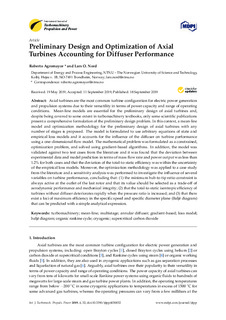| dc.contributor.author | Agromayor, Roberto | |
| dc.contributor.author | Nord, Lars O. | |
| dc.date.accessioned | 2019-09-18T14:05:17Z | |
| dc.date.available | 2019-09-18T14:05:17Z | |
| dc.date.created | 2019-09-18T15:54:14Z | |
| dc.date.issued | 2019 | |
| dc.identifier.citation | International Journal of Turbomachinery, Propulsion and Power. 2019, 4 (3), . | nb_NO |
| dc.identifier.issn | 2504-186X | |
| dc.identifier.uri | http://hdl.handle.net/11250/2617490 | |
| dc.description.abstract | Axial turbines are the most common turbine configuration for electric power generation and propulsion systems due to their versatility in terms of power capacity and range of operating conditions. Mean-line models are essential for the preliminary design of axial turbines and, despite being covered to some extent in turbomachinery textbooks, only some scientific publications present a comprehensive formulation of the preliminary design problem. In this context, a mean-line model and optimization methodology for the preliminary design of axial turbines with any number of stages is proposed. The model is formulated to use arbitrary equations of state and empirical loss models and it accounts for the influence of the diffuser on turbine performance using a one-dimensional flow model. The mathematical problem was formulated as a constrained, optimization problem, and solved using gradient-based algorithms. In addition, the model was validated against two test cases from the literature and it was found that the deviation between experimental data and model prediction in terms of mass flow rate and power output was less than 1.2% for both cases and that the deviation of the total-to-static efficiency was within the uncertainty of the empirical loss models. Moreover, the optimization methodology was applied to a case study from the literature and a sensitivity analysis was performed to investigate the influence of several variables on turbine performance, concluding that: (1) the minimum hub-to-tip ratio constraint is always active at the outlet of the last rotor and that its value should be selected as a trade-off of aerodynamic performance and mechanical integrity; (2) that the total-to-static isentropic efficiency of turbines without diffuser deteriorates rapidly when the pressure ratio is increased; and (3) that there exist a loci of maximum efficiency in the specific speed and specific diameter plane (Baljé diagram) that can be predicted with a simple analytical expression. | nb_NO |
| dc.language.iso | eng | nb_NO |
| dc.publisher | MDPI | nb_NO |
| dc.relation.uri | https://www.mdpi.com/2504-186X/4/3/32 | |
| dc.rights | Attribution-NonCommercial-NoDerivatives 4.0 Internasjonal | * |
| dc.rights.uri | http://creativecommons.org/licenses/by-nc-nd/4.0/deed.no | * |
| dc.title | Preliminary Design and Optimization of Axial Turbines Accounting for Diffuser Performance | nb_NO |
| dc.type | Journal article | nb_NO |
| dc.type | Peer reviewed | nb_NO |
| dc.description.version | publishedVersion | nb_NO |
| dc.source.pagenumber | 30 | nb_NO |
| dc.source.volume | 4 | nb_NO |
| dc.source.journal | International Journal of Turbomachinery, Propulsion and Power | nb_NO |
| dc.source.issue | 3 | nb_NO |
| dc.identifier.doi | 10.3390/ijtpp4030032 | |
| dc.identifier.cristin | 1726378 | |
| dc.relation.project | Norges forskningsråd: 255016 | nb_NO |
| dc.relation.project | Norges forskningsråd: 257632 | nb_NO |
| dc.description.localcode | (C) 2019 by the authors. Licensee MDPI, Basel, Switzerland. This article is an open access article distributed under the terms and conditions of the Creative Commons Attribution NonCommercial NoDerivatives (CC BY-NC-ND) license (https://creativecommons.org/licenses/by-nc-nd/4.0/). | nb_NO |
| cristin.unitcode | 194,64,25,0 | |
| cristin.unitname | Institutt for energi- og prosessteknikk | |
| cristin.ispublished | true | |
| cristin.fulltext | original | |
| cristin.qualitycode | 1 | |

